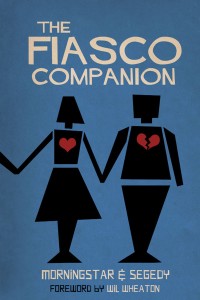 So here it is. The long-awaited companion (dare I say sequel?) volume to Fiasco is here, and it’s ready to make several bad situations a whole Hell of a lot worse. (Believe it or not, this is a favorable review!)
So here it is. The long-awaited companion (dare I say sequel?) volume to Fiasco is here, and it’s ready to make several bad situations a whole Hell of a lot worse. (Believe it or not, this is a favorable review!)
This book, by Jason Morningstar and Steve Segedy, explores the game Fiasco and the ways it’s been played in the time since it’s been published. (In case you’re curious about my opinions of the actual game, read my review here.) Familiarity with Fiasco is absolutely necessary to grasp the ins and outs of this tome. I guess the best way to go from here is a section by section breakdown of the book as it’s presented.
Part 1: Beehive Tetherball
This section runs down different ways to make your experience of the game more reminiscent of the types of storytelling that inspire it. As a fan of both improvisation and good writing, I know a great deal of what this part entails. There are things that I never considered, though. When I’m improvising, for example, my mind tends to work in a fairly linear manner. The idea of breaking that in a story-driven game is at the same time exciting and terrifying. It feels like a risk worth taking.
After scaring the bejeezus out of me, the section goes on to talk about common pitfalls one may experience in a session. The tips offer some great guidance for ways out once a game has painted itself into a corner, and there is certainly no fear of walking proudly across a floor of wet paint.
Part 2: Herding Leopards
Here we see topics that relate to being “in charge” of Fiasco. While it’s a GM-less game, there’s no reason that someone couldn’t step up and adjudicate if things get weird. (Here’s a hint: They will.) It is important to note that, just because there’s no GM, it doesn’t mean that people are expressly prohibited from being in such a position should the need arise. It absolutely needed to be said.
Part 3: 144 Ways to Hurt a Dude
One of the more useful (not that the rest of it isn’t) chapters in the book, this one outlines how to make your own Playsets. One might think the only thing you have to do is throw together random lists of things and roll with it, but that’s simply not the case, and here we get into some of the dirty details on how to make that work. I find the “pro tips” section to be especially useful, as ideas in here can help turn a workable Playset into a burgeoning Fiasco.
“…ideas in here can help turn a workable Playset into a burgeoning Fiasco.”
Part 4: Spiking the Punch
I’d like to take a moment to mention my thoughts on this section’s title. Given its content, I though it was a metaphor for making the game your own by doing something like adding spikes to your boxing glove, like the Roman cestus. Not once did it occur to me that it might just be about adding fun by boozing up the punch bowl. I guess either interpretation works, but I need to laugh at my own over-thinking.
Like I said above, this section is about modifying the game. Some call it homebrewing, but here they call it “creating a theme package”. It’s a reasonable way of putting it. The rules to this game are mutable by design, and altering the rules to manufacture a specific effect really speak to this notion.
I love the idea of stunt dice, not just for the opportunities presented in the book, but also for other concepts that can be thrown in as modifiers. I see the idea of chase scenes, shootouts, and others. Here’s one (feel free to take it if you think it’ll work for you):
- Conflict resolution: If two players are playing characters that don’t like each other, a player may, on his turn decide it’s time to air the thing out and have the two characters go for the throat. This is probably the sort of thing that’s best to happen after the Tilt, and the Resolution of the scene can determine who wins the argument/fight.
This is what happens when game designers lift the hood, and show you how the machine runs. Fiasco isn’t a terribly complex machine, but it sure lends itself to endless modification.
Further along in this Part, we get new Tilt and Aftermath tables (for “softer” games), and some new Playsets:
- Fiasco High: for games set in high school, where you can live out all of your John Hughes fantasies (except for the one where you leave your youngest child at home while you go on vacation).
- Regina’s Wedding: Have you ever been to a wedding where everything went according to plan? Yeah, neither have I. This Playset walks you down the aisle and pushes you off a cliff, if you’re lucky.
- Vegas: I have been waiting for this one. I know it was available for special release at a convention when Fiasco first came out, and it has been worth the wait.
- Mission to Mercury: I actually wanted to write this Playset before I realized that I know nothing about space exploration. All I wanted to do was modify the existing Playset about being on a submarine (Objective Zebra – find it here), and alter it so the thing happens in space. This Playset is clearly more in-depth, and does a far better job than I could have imagined.
Part Six: Feeding the Woodchipper
That header keeps cracking me up. Every time I read it, images of Fargo shoot across my brain like a lightning bolt of blood and snow. Of course, it relates to putting things into the machine to make it work, but still.
In this section, the writers cover other uses for Fiasco that don’t limit it sitting around a table for ridiculous fun. You can take that ridiculous fun elsewhere. Notably, there are interviews here with people who have used Fiasco in different ways that play to their fields of expertise. You have teachers, writers, and the one I can speak to, which is performers.
As I said in my first review of the game, I am an improviser. I saw this game and thought it’s a great setup for performance quality improvisation. If all goes well, I may get my chance. Here, the performers being interviewed do mention crafting the game into a performance, but the focus is more on acting exercise, and how Fiasco does that very well. There’s a lot for the actor/improviser to learn about their craft if they can just pick up and play, a point driven home in the interview.
Part six ends with Wheaton’s Big Six, which are play tips from the well-known actor (who, incidentally, also wrote the Foreword). It’s a quick list that really encapsulates how to play a good Fiasco, and shows Mr. Wheaton to possibly have an unhealthy fondness for firearms. Either that, or he really gets this game. I’m betting it’s the latter.
Conclusion
Another well put together book. While it doesn’t help the uninitiated very much, what companion volume does without the source material? It would be like having C-3PO without R2-D2. Sure, it’s nice to have something that can speak to your moisture vaporators and binary load lifters, but without a way to maintain them in the first place, you just have a nice looking door stop. Luckily, this book is more than just that. It helps drive home the notion that there are a lot of good lessons about role-playing that one can pick up from Fiasco, and gives you just a few more.
I welcome your comments.
Watch your threatened squares.


Thanks for the review Seamus! I’m glad you like the book.
“…all of your John Hughes fantasies (except for the one where you leave your youngest child at home while you go on vacation)”
Hah! Keep an eye out for the “North Shore” Playset, coming soon…
Oooh, yes, I’m so going to buy that book. My gaming group is addicted to Fiasco anyway, so let’s see how bad it gets with this. I’ve been wanting to create my own playset for a while now, so the tips for that will come in handy.
Thank you for the review. I had the same reaction to spiking the punch, by the way :D